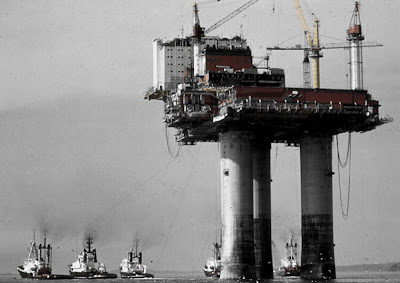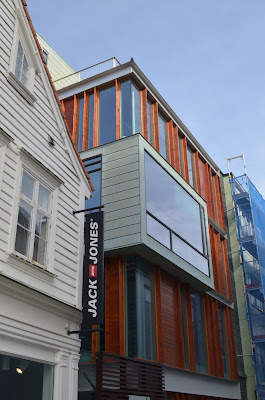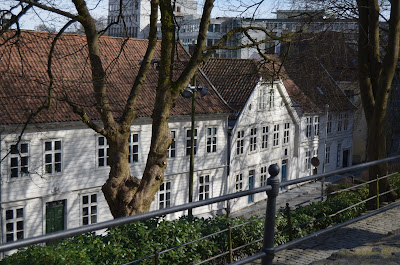I grew up on the southwestern rim of Norway, where I guess you could say
the landscape is quite similar to the danish westcoast. A half hours drive inland is where your Figgjo is
made! You won't find images of this place in a tourism brouchure, they
tend to only show what's considered typical norwegian, fjords surrounded
by mountains and blooming apple trees. That's an image that has stuck
ever since the poets of the romantic period of the late 1800s considered
the southwestern flat and windy coast a very gloomy place with low
ground- hugging houses made of timber from shipwrecks on the rugged
coast.
Above is an old traditional farmhouse, low and ground- hugging, shaped to let the wind pass over it. Below is a beautiful old vicorage by the ocean, which has been turned into a great gallery for modern art.
I'm happy to observe these days that
there's a growing amount of young people seeking the wonderful surfing
conditions this stretch of coast has, and thereby treasuring the
beautiful landscape. The tough guys come in the winter when the largest
waves roll in from the North Sea, in summer when everything has calmed
down, you can take surfing classes.
The climate is mild and the differences between winter and summer are not as great as in other parts of the country. There is rarely snow in the winter, mostly rain and wind. The
landscape is very flat and there are long stretches of sandy
beach, altogether 70 kilometres, the rest is filled with stones that the
glaciers of the ice age left there. Today this is one of this country's
largest farm regions. When I walk the stoney stretches of coast that
are now protected by law, knowing the whole region was once like
this, I'm always in awe of all the hard labour that was put into
removing all that stone from the ground. Of course, a beautiful result
of this labour is that the area is overstrewn with amazing stone fences.
Along the stoney coast there are a lot of bronze age and iron age grave sites, that look like
slightly more geometric clusters of stone. Many of these have contained
artefacts from the other side of the North sea, showing the degree of
interaction our seafaring ancestors had. Much more than with the inland
parts of Norway. I guess growing up on the coast always makes you
curious of what's on the other side of the ocean.
A great number of WW2 bunkers can be seen along the beaches. These were part of the german Atlantic wall and were meant to stop allied forces from the UK.
The focus on this region in modern times has mostly been on Stavanger as
Norway's oil capital. My coastal home town grew rapidly from the late
60s when oil was discovered off our shore, and turned into an
international city, very different from our other cities at that time.
Until then, the city was shaped by its shipping, fishery and canning industry. We
experiensed some pretty amazing times when the oil rigs built there
became part of the cityscape and dwarfed the historic wooden houses.
When they were ready, we found a good viewpoint and watched the
giants start their journey out to the oil fields in the North sea.
Ocean vessels then and now. The green one is a supply ship for North sea oil rigs. Below are images from the old town, that once housed employees of the canning factories.
Ocean vessels then and now. The green one is a supply ship for North sea oil rigs. Below are images from the old town, that once housed employees of the canning factories.
My childhood kingdom is rugged, often
stormy and grey, but to me, it's the most beautiful place on earth! I
miss it so much and hope one day I can move back:-) I'm sure you all
come from amazing places too, whether you feel closest to where you
spent your childhood or where you live now. Feel like sharing?

































What a rugged, beautiful place to call home. I can see why you love it so much. I'll try to find some good photos of the parts of East Texas and Louisiana I lived in when I was young and write a post about them.
ReplyDeleteI'd love to see those places, I look forward to that!
DeleteI think I want to go to Norway on holidays..have been thinking about for some time now( vintage heaven
ReplyDeleteDo come:-) We have great scenery, clean air and vintage goodies, the only thing I can't guarantee is the weather!
DeleteI'm sold! What a lovely post Tove! I will reciprocate soon xx
ReplyDeleteThank you so much Pippa, I'm glad you liked it!
ReplyDeleteSooooooo beautiful! And so very different from the southwest desert! Definitely must get to Norway one day. Thanks for sharing such lovely photos and memories.
ReplyDeleteThank you so so much, Francine, I'm so glad you liked it! I have to tell you my husband and I spent a couple of weeks in Arizona around 15 years ago (pre- kids!) and that's a vacation I'll never forget. Your home state is amazing!!
DeleteHei fra Tromsø. Fant bloggen din gjennom Kaylovesvintage. Ser ut som vi har felles interesser! Jeg følger deg fra nå av:)
ReplyDeleteHei! Så hyggelig! Kjekt at du vil følge meg:-) Gleder meg til å sjekke ut bloggen din!
ReplyDeleteI'm here from Pippa at Ouchflower. What a beautiful place you grew up in. I have always been curious about Norway as my great grandfather was from Bergen apparently. He travelled to Tahiti where he had a son...and the rest is history.
ReplyDeleteI hope one day to visit Norway. Thanks for your tour. xx
Hi there! Wow, part Norwegian, part Tahitian, what a great blend! Well, we sure are a nation of sailors:-)
DeleteBergen is a wonderful city, you'd love it! It's a bit further north on the west coast from my southern "corner", and it has mountains. It's more like the typical image of Norway from the tourist brochures:-)
Thank you so much for joining my blog! I'll be sure to check out yours too, I'm looking forward to it! Pippa is a regular matchmaker, right?
She sure is! I'm thrilled to have found you as you seem to have a great love for vintage ceramics like me. I love finding out the history of the pieces, so will enjoy reading about your discoveries. xx
Delete